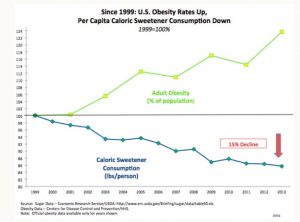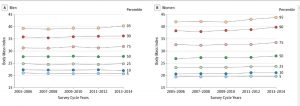Sugar politics: San Francisco
My daughter, Rebecca Nestle, sends these from Valencia Street, San Francisco, August 2016.
There was this booth.

And this unidentified person wearing a great tee shirt:

My daughter, Rebecca Nestle, sends these from Valencia Street, San Francisco, August 2016.
There was this booth.

And this unidentified person wearing a great tee shirt:

My book, Soda Politics, came out not quite a year ago but so much has happened since then that it’s been hard to keep up with everything that’s happening in campaigns to discourage consumption of sugar-sweetened beverages.
Fortunately, Healthy Food America’s Casey Hinds puts out a daily roundup of sugar and soda news (you can sign up for it and HFA’s other materials here).
A few recent items of particular interest:
USA Today’s editorial, “soda taxes fall flat“
More effective ways already are being used to change people’s diets. The best use of government authority is to empower people with the information they need to make healthier choices.
The editorial comes with a poll, still up. You can vote on it here. At this moment only 183 votes have come in, 51% strongly in favor of the editorial opinion.
Jim Krieger of Healthy Food America did a counterpoint
The time has come to tax sugary drinks like we tax tobacco. The analogy is powerful: As with tobacco, rock-solid evidence shows habitual use harms health. Sugary drinks are a prime culprit in rampant health problems — diabetes, obesity, and heart, dental and liver disease – that cut lives short and drive up health care costs. Tobacco taxes have reduced smoking, while raising money to make lives better. Taxing sugary drinks would do the same
This too has a poll on which you can still vote. Only 92 votes have come in, and only 38% strongly agree.
Americans don’t like taxes. Even so, either this issue doesn’t generate much interest or it’s just August and too hot to think about such things.
The beverage industry spent $10.6 million to oppose Philadelphia’s soda tax initiative
The soft drink industry does not like taxes and seems willing to put fortunes into opposing them.
The Philadelphia City Council passed the tax anyway. I keep thinking of all the good things nearly $11 million could do for public health.
Melbourne’s The Alfred Hospital reduces sugary drink consumption
The hospital did an experiment to see if they could shift the mix of drinks purchased from sugary to less sugary. They did this by increasing the price of sugary drinks and hiding them under counters. Sales of sugar-sweetened beverages sales fell by 36,500 drinks in a year.
I don’t get it. Why not just stop selling them altogether?
That’s it for this August Monday. Stay cool. More to come.
Addition, August 23
A reader from New Zealand writes to say that “all of its hospitals no longer sell sugary sodas and some are also beginning to remove juice and artificially sweetened beverages due to their acidic nature and detrimental impact on oral health.”
I can hardly keep up with news about sugar these days. Here are a bunch of items that I thought worth notice.
Healthy Food America has produced a Sugar Advocacy Toolkit
Now is the time to act. Scientific evidence of the harm caused by added sugars is strong and growing. News stories have begun sounding the alarm. Some Americans are getting the message that sugar is unhealthy and are cutting back, but consumption remains high along with health impacts associated with overconsumption.
Corporate Europe Observatory has produced a report, A Spoonful of Sugar: How the food lobby fights sugar regulation in the EU. Here’s how:
Good news: A textual analysis of sugar industry influence on the World Health Organization’s 2015 sugars intake guideline shows that WHO mostly resisted the lobbying (here’s the entire paper).
There was little change between draft and final versions of the WHO sugars intake guideline 2015, following industry consultation. The main change was linked to emphasizing the low quality of the evidence on sugar’s adverse effects. Guideline development appeared relatively resistant to industry influence at the stakeholder consultation stage.
Britain’s Food and Drink Federation issued reformulation guidelines for small- and medium-sized businesses on how to reduce sugar and label sugars.
How’s this for a headline: Food lobby rigs EU sugar laws while obesity and diabetes spiral out of control.
Another headline: Big Sugar’s Fanjul Family Hosting Miami Fundraisers for Both Clinton and Trump This Year [The Fanjuls have long been equal opportunity funders]
From The Hagstrom Report:
House Agriculture Committee Chairman Michael Conaway, R-Texas, Senate Agriculture Committee ranking member Debbie Stabenow, D-Mich., and Alexis Taylor, a high ranking Agriculture Department official, all committed themselves to the future of the U.S. sugar program today as industry officials and analysts talked about the struggles that beet producers and cane refiners are experiencing in the midst of imports from Mexico and the controversy surrounding genetically modified foods [Comment: recall that US sugar prices are higher than world market prices because of tariffs and quotas, and that every attempt to drop these measures has failed under lobbying pressures].
KIND bars are the first to label added sugars.
As Grub Street puts it, all food companies are scrambling to reduce their sugars.
It will still be two years before nutrition labels have to get seriously transparent about their sugar content, yet it looks like the countdown is already starting to make Big Food squirm. Added sugar is both omnipresent in Americans’ diets and actively loathed for that very reason. So in May, when the FDA announced new labels had to disclose the number of grams, experts’ hunch was that many products were about to suddenly become a lot less sweet. This prediction was pretty spot-on, if Bloomberg’s new report on Kind is any indication: The snack-bar-maker just became the first company to start voluntarily labeling sugar content, and — surprise, surprise — there’s a lot less sugar in there.

Enough for now. More to come. Have a sweet weekend.
The Los Angeles Times has reprinted a story about Big Sugar’s hold on Florida politics. The story appeared first in the Miami Herald (but don’t even try to read it there; the ads make the site impenetrable).
The LA Times version is worth a look.
Between 1994 and 2016, a review of state Division of Elections records by The Miami Herald/Tampa Bay Times Tallahassee bureau shows, the sugar industry led by United States Sugar and Florida Crystals has steered a whopping $57.8 million in direct and in-kind contributions to state and local political campaigns. (The total does not include federal contributions.)
It appears to be money well spent. On issue after issue, regulators, legislators and governors have erred on the side of softening the impact of adverse rules and regulations on cane growers and other powerful and polluting agriculture interests, including cattle operations north of Lake Okeechobee.
The sugar industry beat back a voter-approved amendment that would have forced it to pay for cleaning up its own nutrient-rich runoff into the Everglades, instead shifting much of the cost to taxpayers. It won repeated delays of strict water quality standards. It has fended off calls for buyouts even after one of the largest companies, U.S. Sugar, offered to sell itself to the state. And it has undermined attempts to use a second constitutional amendment, Amendment 1, to be used to buy farmland for Everglades cleanup.
You have to love U.S. sugar policy. It’s just so weird.
On the one hand, we have dietary guidelines that say “Limit calories from added sugars.”
On the other, we support sugar prices with a system of sugar quotas and tariffs that makes U.S. sugar cost more than sugar on the world market (but not enough to decrease consumption).
We let sugar producers indiscriminately pollute land and water and “encourage” elected officials to turn a blind eye and shift the costs of cleanup to taxpayers.
If ever we needed evidence why linking agricultural policy to health and environmental policies is so essential, the contradictions of sugar policy make the case.
While I was in Israel last week, Time Magazine published an op-ed it had invited me to write. Here it is.
Nutrition professor that I am, if I could teach just one thing to the American public, it is this: Larger portions have more calories.
Please don’t laugh.
If we all understood this, the United States would not have an obesity problem. And the recent revelation that places like Chipotle and Panera serve meals with more calories than McDonald’s would surprise nobody. We would realize the former’s “health” aura blinds people. But this basic rule applies to those places, too.
We would also, strangely, thank McDonald’s for at least one thing: It limits portion sizes. It’s easy to pile on calories by asking for a little more of this, then a refill of that—without realizing that the calories surpass those in McDonald’s meals.
It’s not easy to understand calories. They are not intuitive because they’re abstract. They cannot be seen, tasted or smelled, and are extraordinarily difficult to count accurately, even for scientists. My colleague Lisa Young, author of The Portion Teller, once asked an entry-level nutrition class to guess the calories in 8-ounce and 64-ounce soft drinks. We didn’t expect students to know that an 8-ounce Coke has 100 calories—but we certainly expected them to multiply whatever they guessed by eight for the 64-ounce drink. But the average multiplier was three.
The unintuitive relationship between amounts eaten and calorie intake is one of the reasons behind public health campaigns like the new soda tax in Philadelphia, which in part aims to get people to think twice before drinking sugary beverages. No nutritionist worries about an occasional 90-calorie mini-can of soda. But many people drink sugary beverages in 12-ounce, 20-ounce or liter sizes. Bigger sizes mean more calories, and more calories means more weight unless you compensate with physical activity.
But exercising off calories takes a lot of work. That was the message of aNew York City health department campaign demonstrating the need to walk the three miles from Union Square to Brooklyn to compensate for the nearly 300 calories in a 20-ounce soft drink.
And let’s not forget that all of the calories in soft drinks come from sugars, which provide nothing but calories—no vitamins, no minerals, no fiber. They may be delicious, but they have no redeeming nutritional value. That’s why their calories get called “empty.”
Does where calories come from make any difference? Yes, but in complicated ways. Weight balance depends on calories. But managing weight—and overall health—very much depends on where those calories come from. It’s not so easy to overeat vegetables, fruits and whole grains, or relatively unprocessed foods of any kind, because these tend to be bulky and fill you up before you eat too much. You can still gain weight on these healthy foods, but it’s harder. Chipotle may have healthier calories than McDonald’s, but its calories still count.
Sugars post particular problems because they induce insulin production, but also because they make foods taste good. We eat something sweet and want more of it. We start loving sweet tastes in infancy. Breast milk is sweet; it contains a tablespoon of lactose per cup and that’s there for a reason—to make babies do the work of nursing.
But sodas are very sweet. A 12-ounce soda contains more than threetablespoons of sugars—and the calories that go with them.
It’s also very hard to separate the effects of sugars from their calories. If scientists want to know whether the calories from sugars are worse than those from any other foods, they need to feed people precisely the same number of calories from diets widely varying in their content of sugar, other carbohydrates, protein, and fat for a long enough period of time to get meaningful results. The only way to do something like this would be to keep the study subjects under lock and key for as long as it takes—inconvenient, to say the least, and very expensive.
Until the science is resolved, we can all agree that eating less sugar is a good idea for just about everyone. Sugars are nutritionally empty, are hidden in foods, and encourage overeating.
Notice that I said less, not none. Personally, I love desserts and would never want to give up sugars entirely or ask anyone else to do so. I just follow my own dietary advice: eat lots of vegetables and other relatively unprocessed “real” foods, and for everything else, pay attention to portion size. This way, an occasional sugary treat is a pleasure and nothing to worry about.
Marion Nestle is professor of nutrition, food studies, and public health at New York University and co-author of Why Calories Count. Her most recent book is Soda Politics: Taking on Big Soda (and Winning).
I’m in Israel this week where “eat-less-sugar” is just as big an issue as it is in the United States (translation: “without sugar”)

The U.S. Sugar Association is using an article in JAMA about the rising prevalence of obesity to argue that sugar cannot be responsible. Sugar intake has declined in the U.S. since 2000, largely because of the decline in consumption of soft drinks.
Sugar, says the Sugar Association, cannot cause obesity (it’s energy balance).
Evidence? The numbers don’t add up.

Oops. Better take a look at the actual data from the JAMA paper:

What this figure shows is only a small increase in obesity over the last 10 years for men (on the left) and women (on the right)—for those above the 50th percentile of body mass index.
My interpretation:
Most Americans consume twice the sugar recommended. Less would be better, but the “10% of calories” recommendation still leaves plenty of room for dessert.
I mentioned yesterday that whenever something comes out saying that “everything you thought you knew about nutrition is wrong,” it’s a sign that some skepticism may be in order.
Here is another example: The article on the “sugar conspiracy“ by Ian Leslie published in The Guardian. This strongly criticizes the work of Ancel Keys, whose work was largely but by no means exclusively responsible for the diet-heart hypothesis linking excessive intake of animal fats to heart disease risk.
I love conspiracy theories as much as anyone else and appreciated how the author made his case for this one. My sense of his article was that it had grains of truth (Gary Taubes and Cristin Kearns, for example, report that Keys had funding from the sugar industry). But the overall thrust of the article seemed excessively hyperbolic and based on selective picking of the data (cherry-picking).
Going through the piece line by line to identify errors and misinterpretations was not something I thought worth the trouble.
Fortunately, someone else did.
Katherine Docimo Pett, a master’s degree candidate in biochemical and molecular nutrition at Tufts University, who blogs as Nutrition Wonk, sent me her detailed critique of the paper. She explains:
So I decided to look into the Seven Countries Study and I found a number of occasions where “The Sugar Conspiracy” misinterprets the evidence. So buckle yourselves up, conspiracy theorists, because in this post, I’m going to cover the history of the diet-heart hypothesis – namely The Seven Countries Study and the subsequent research mentioned in “The Sugar Conspiracy.”
If you can wade through her lengthy analysis, you will be hard pressed to disagree with her conclusion:
In “The Sugar Conspiracy,” the author makes a lot of assumptions about intent, the usefulness of epidemiology, and even the conclusions of papers. However, upon closer inspection, a lot of his evidence doesn’t hold up under scrutiny.
The idea that Keys claimed in his Seven Countries Study that correlation proved causation is false. Keys just said that cholesterol is a mediator for heart disease and that saturated fat raises cholesterol, both of which later turned out to be true. The Menotti “reanalysis” did not find that sugar is more closely correlated with heart disease than fat, and even if it did, it is a simple regression – it controlled for zero confounders, way fewer than were controlled for in the original Seven Countries Study. Finally, there is plenty of evidence to suggest that substituting saturated fatty foods in favor of unsaturated fats is a good idea [Clarification: she must mean substituting unsaturated for saturated].
It is absolutely worthwhile to debate the merits of all scientific findings or even the merits of an entire field, like epidemiology. Scientists, even nutrition scientists, do this all the time. The problem, though, is that if basic facts are actually based on misinformation, you can’t build a real case for or against anything.
Amen.
Footnote: Sarah Tracy, an historian at the University of Oklahoma, has been working on a biography of Ancel Keys for quite some time. I can’t wait for her to get it done (she probably can’t either), as it is likely to give us a thoughtful, balanced account of the significance of his work.
The USDA has just done a write up on a study it funded in collaboration with the National Honey Board: Consumption of Honey, Sucrose, and High-Fructose Corn Syrup Produces Similar Metabolic Effects in Glucose-Tolerant and -Intolerant Individuals.
This was one of the 12 industry-negative studies I posted to my collection of 168 industry-funded studies from March 2015 to March 2016.
The USDA article explains:
Controversy exists over whether all sweeteners produce the same metabolic effects in consumers despite the sweeteners’ chemical similarities. A study conducted by U.S. Department of Agriculture (USDA) researchers indicates that consuming lower amounts of added sugars is a more effective approach to health than finding a sugar that is more neutral in terms of its health effects…Volunteers [consuming honey, white cane sugar, or HFCS] did not show any differences in blood sugar levels based on the dietary sugar source. In addition, blood levels of triglyceride, an indicator of blood fat concentrations (a marker for heart disease risk), increased in response to all three sugars tested.
White cane sugar is 50% glucose and 50% fructose, linked together (but quickly separated in the body). Honey and High Fructose Corn Syrup are glucose and fructose, already separated, but with slightly higher percentages of fructose. Biochemically, they are not all that different.
So the results of this study, disappointing as they may have been to the Honey Board, were predictable on the basis of basic sugar biochemistry.